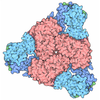+ Open data
Open data
- Basic information
Basic information
| Entry | Database: PDB / ID: 3tf3 | ||||||
|---|---|---|---|---|---|---|---|
| Title | Crystal structure of metal-free Human Arginase I | ||||||
 Components Components | Arginase-1 | ||||||
 Keywords Keywords | HYDROLASE / ARGINASE FOLD | ||||||
| Function / homology |  Function and homology information Function and homology informationpositive regulation of neutrophil mediated killing of fungus / Urea cycle / negative regulation of T-helper 2 cell cytokine production / arginase / : / arginase activity / urea cycle / response to nematode / defense response to protozoan / negative regulation of type II interferon-mediated signaling pathway ...positive regulation of neutrophil mediated killing of fungus / Urea cycle / negative regulation of T-helper 2 cell cytokine production / arginase / : / arginase activity / urea cycle / response to nematode / defense response to protozoan / negative regulation of type II interferon-mediated signaling pathway / negative regulation of activated T cell proliferation / L-arginine catabolic process / negative regulation of T cell proliferation / specific granule lumen / azurophil granule lumen / manganese ion binding / adaptive immune response / innate immune response / Neutrophil degranulation / extracellular space / extracellular region / nucleus / cytosol / cytoplasm Similarity search - Function | ||||||
| Biological species |  Homo sapiens (human) Homo sapiens (human) | ||||||
| Method |  X-RAY DIFFRACTION / X-RAY DIFFRACTION /  SYNCHROTRON / SYNCHROTRON /  MOLECULAR REPLACEMENT / Resolution: 1.64 Å MOLECULAR REPLACEMENT / Resolution: 1.64 Å | ||||||
 Authors Authors | D'Antonio, E.L. / Christianson, D.W. | ||||||
 Citation Citation |  Journal: Biochemistry / Year: 2011 Journal: Biochemistry / Year: 2011Title: Crystal structures of complexes with cobalt-reconstituted human arginase I. Authors: D'Antonio, E.L. / Christianson, D.W. | ||||||
| History |
|
- Structure visualization
Structure visualization
| Structure viewer | Molecule:  Molmil Molmil Jmol/JSmol Jmol/JSmol |
|---|
- Downloads & links
Downloads & links
- Download
Download
| PDBx/mmCIF format |  3tf3.cif.gz 3tf3.cif.gz | 130.9 KB | Display |  PDBx/mmCIF format PDBx/mmCIF format |
|---|---|---|---|---|
| PDB format |  pdb3tf3.ent.gz pdb3tf3.ent.gz | 102.5 KB | Display |  PDB format PDB format |
| PDBx/mmJSON format |  3tf3.json.gz 3tf3.json.gz | Tree view |  PDBx/mmJSON format PDBx/mmJSON format | |
| Others |  Other downloads Other downloads |
-Validation report
| Arichive directory |  https://data.pdbj.org/pub/pdb/validation_reports/tf/3tf3 https://data.pdbj.org/pub/pdb/validation_reports/tf/3tf3 ftp://data.pdbj.org/pub/pdb/validation_reports/tf/3tf3 ftp://data.pdbj.org/pub/pdb/validation_reports/tf/3tf3 | HTTPS FTP |
|---|
-Related structure data
| Related structure data | 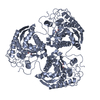 3th7C 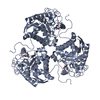 3theC 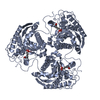 3thhC 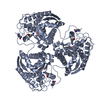 3thjC 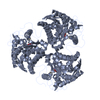 2aebS S: Starting model for refinement C: citing same article ( |
|---|---|
| Similar structure data |
- Links
Links
- Assembly
Assembly
| Deposited unit | 
| ||||||||
|---|---|---|---|---|---|---|---|---|---|
| 1 | 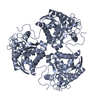
| ||||||||
| 2 | 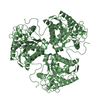
| ||||||||
| Unit cell |
|
- Components
Components
| #1: Protein | Mass: 34779.879 Da / Num. of mol.: 2 Source method: isolated from a genetically manipulated source Source: (gene. exp.)  Homo sapiens (human) / Gene: ARG1 / Plasmid: pBS(KS) / Production host: Homo sapiens (human) / Gene: ARG1 / Plasmid: pBS(KS) / Production host:  #2: Water | ChemComp-HOH / | |
|---|
-Experimental details
-Experiment
| Experiment | Method:  X-RAY DIFFRACTION / Number of used crystals: 1 X-RAY DIFFRACTION / Number of used crystals: 1 |
|---|
- Sample preparation
Sample preparation
| Crystal | Density Matthews: 2.39 Å3/Da / Density % sol: 48.62 % |
|---|---|
| Crystal grow | Temperature: 298 K / Method: vapor diffusion, hanging drop / pH: 7 Details: 0.1 M HEPES, 30% (v/v) Jeffamine ED-2001, 0.014 M thymine, 0.0001 M manganese chloride. following xtal growth, metal-free HAI crystals are prepared by soaking a single crystal in 0.015 M ...Details: 0.1 M HEPES, 30% (v/v) Jeffamine ED-2001, 0.014 M thymine, 0.0001 M manganese chloride. following xtal growth, metal-free HAI crystals are prepared by soaking a single crystal in 0.015 M dipicolinic acid, 0.015 M EDTA, 30% (v/v) Jeffamine ED-2001 for 1 week, pH 7.0, VAPOR DIFFUSION, HANGING DROP, temperature 298K |
-Data collection
| Diffraction | Mean temperature: 100 K |
|---|---|
| Diffraction source | Source:  SYNCHROTRON / Site: SYNCHROTRON / Site:  NSLS NSLS  / Beamline: X29A / Wavelength: 1.075 Å / Beamline: X29A / Wavelength: 1.075 Å |
| Detector | Type: ADSC QUANTUM 315 / Detector: CCD / Date: Sep 22, 2010 Details: Cryogenically cooled double crystal monochrometer with horizontal focusing sagittal bend second mono crystal with 4:1 magnification ratio and vertically focusing mirror |
| Radiation | Monochromator: SAGITALLY FOCUSED Si(111) / Protocol: SINGLE WAVELENGTH / Monochromatic (M) / Laue (L): M / Scattering type: x-ray |
| Radiation wavelength | Wavelength: 1.075 Å / Relative weight: 1 |
| Reflection | Resolution: 1.64→50 Å / Num. obs: 77810 / % possible obs: 99.3 % / Observed criterion σ(F): 0 / Observed criterion σ(I): -3 / Redundancy: 9.8 % / Rmerge(I) obs: 0.08 / Rsym value: 0.08 / Net I/σ(I): 35.185 |
| Reflection shell | Resolution: 1.64→1.7 Å / Redundancy: 9.8 % / Rmerge(I) obs: 0.43 / Mean I/σ(I) obs: 5.459 / Rsym value: 0.43 / % possible all: 95.4 |
- Processing
Processing
| Software |
| ||||||||||||||||||||
|---|---|---|---|---|---|---|---|---|---|---|---|---|---|---|---|---|---|---|---|---|---|
| Refinement | Method to determine structure:  MOLECULAR REPLACEMENT MOLECULAR REPLACEMENTStarting model: PDB ENTRY 2AEB Resolution: 1.64→50 Å / Isotropic thermal model: isotropic / Cross valid method: THROUGHOUT / σ(F): 0 / Stereochemistry target values: Engh & Huber
| ||||||||||||||||||||
| Displacement parameters | Biso mean: 35 Å2 | ||||||||||||||||||||
| Refine analyze |
| ||||||||||||||||||||
| Refinement step | Cycle: LAST / Resolution: 1.64→50 Å
| ||||||||||||||||||||
| Refine LS restraints |
| ||||||||||||||||||||
| LS refinement shell | Resolution: 1.64→1.7 Å
|
 Movie
Movie Controller
Controller



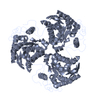
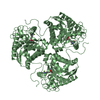
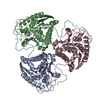
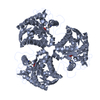
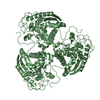
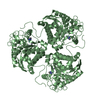

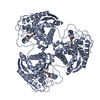




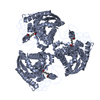
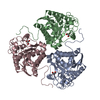

 PDBj
PDBj